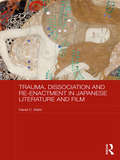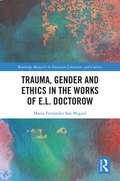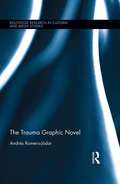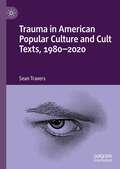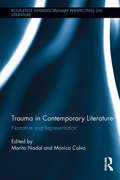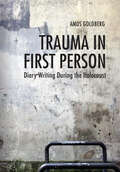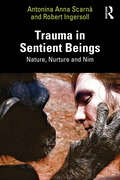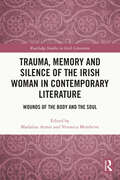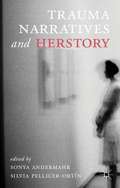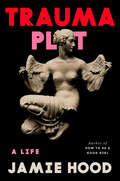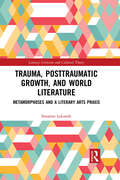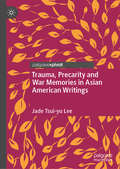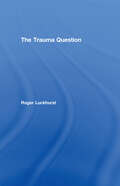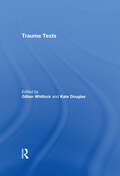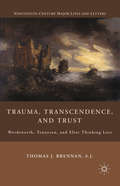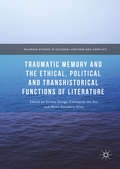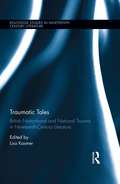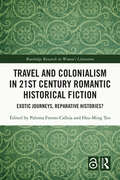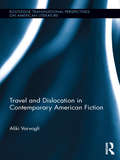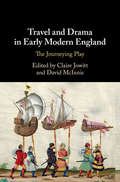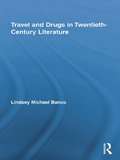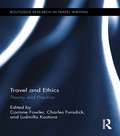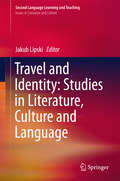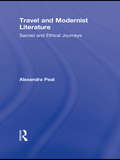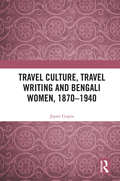- Table View
- List View
Trauma, Dissociation and Re-enactment in Japanese Literature and Film (Routledge Contemporary Japan Series)
by David C. StahlJapanese literature and film have frequently been approached using lenses such as language, genre and ideology. Yet, despite a succession of major social traumas that have marked, and in many ways shaped and defined much of modern Japan, Japanese fiction and cinema have not often been examined psychoanalytically. In this book, David Stahl conducts in-depth readings and interpretations of a set of Japanese novels and film. By introducing the methodology of trauma/PTSD studies, Stahl seeks to provide a better understanding of the insights of Japanese writers and directors into their societies, cultures and histories. In particular, by building on the work of practitioner-theoreticians, such as Pierre Janet and Judith Herman, Stahl analyses a number of key texts, including Kawabata Yasunari’s Sleeping Beauties (1961), Enchi Fumiko’s Female Masks (1958) and Imamura Sho- hei’s Vengeance is Mine (1979). Consequently, through using concepts of social trauma, dissociation, failed mourning, revenge and narrative memory, this book sheds new light on the psychological aftereffects and transgenerational legacies of trauma depicted in Japanese works. Trauma, Dissociation and Re-enactment in Japanese Literature and Film will be of interest to students and scholars of Japanese Literature and Cinema, as well as those interested in Japanese History and Trauma Studies.
Trauma, Gender and Ethics in the Works of E.L. Doctorow (Routledge Research in American Literature and Culture)
by María Ferrández San MiguelThis project approaches four of E. L. Doctorow’s novels—Welcome to Hard Times (1960), The Book of Daniel (1971), Ragtime (1975), and City of God (2000)—from the perspectives of feminist criticism and trauma theory. The study springs from the assumption that Doctorow’s literary project is eminently ethical and has an underlying social and political scope. This crops up through the novels’ overriding concern with injustice and their engagement with the representation of human suffering in a variety of forms. The book puts forward the claim that E.L. Doctorow’s literary project—through its representation of psychological trauma and its attitude towards gender—may be understood as a call to action against both each individual’s indifference and the wider social and political structures and ideologies that justify and/or facilitate the injustices and oppression to which those who are situated at the margins of contemporary US society are subjected.
The Trauma Graphic Novel (Routledge Research in Cultural and Media Studies)
by Andrés Romero-JódarThe end of the twentieth century and the turn of the new millennium witnessed an unprecedented flood of traumatic narratives and testimonies of suffering in literature and the arts. Graphic novels, free at last from long decades of stern censorship, helped explore these topics by developing a new subgenre: the trauma graphic novel. This book seeks to analyze this trend through the consideration of five influential graphic novels in English. Works by Paul Hornschemeier, Joe Sacco, Art Spiegelman, Alan Moore and Dave Gibbons will be considered as illustrative examples of the representation of individual, collective, and political traumas. This book provides a link between the contemporary criticism of Trauma Studies and the increasingly important world of comic books and graphic novels.
Trauma in American Popular Culture and Cult Texts, 1980-2020
by Sean TraversThis book examines trauma in late twentieth- and twenty-first century American popular culture. Trauma has become a central paradigm for reading contemporary American culture. Since the early 1980s, an extensive range of genres increasingly feature traumatised protagonists and traumatic events. From traumatised superheroes in Hollywood blockbusters to apocalyptic-themed television series, trauma narratives abound. Although trauma is predominantly associated with high culture, this project shows how popular culture has become the most productive and innovative area of trauma representation in America. Examining film, television, animation, video games and cult texts, this book develops a series of original paradigms through which to understand trauma in popular culture. These include: popular trauma texts’ engagement with postmodern perspectives, formal techniques termed ‘competitive narration’, ‘polynarration’ and ‘sceptical scriptotherapy’, and perpetrator trauma in metafictional games.
Trauma in Contemporary Literature: Narrative and Representation (Routledge Interdisciplinary Perspectives on Literature)
by Marita Nadal Mónica CalvoTrauma in Contemporary Literature analyzes contemporary narrative texts in English in the light of trauma theory, including essays by scholars of different countries who approach trauma from a variety of perspectives. The book analyzes and applies the most relevant concepts and themes discussed in trauma theory, such as the relationship between individual and collective trauma, historical trauma, absence vs. loss, the roles of perpetrator and victim, dissociation, nachträglichkeit, transgenerational trauma, the process of acting out and working through, introjection and incorporation, mourning and melancholia, the phantom and the crypt, postmemory and multidirectional memory, shame and the affects, and the power of resilience to overcome trauma. Significantly, the essays not only focus on the phenomenon of trauma and its diverse manifestations but, above all, consider the elements that challenge the aporias of trauma, the traps of stasis and repetition, in order to reach beyond the confines of the traumatic condition and explore the possibilities of survival, healing and recovery.
Trauma in First Person: Diary Writing During the Holocaust
by Amos GoldbergAn examination of what can be learned by looking at the journals and diaries of Jews living during the Holocaust.What are the effects of radical oppression on the human psyche? What happens to the inner self of the powerless and traumatized victim, especially during times of widespread horror? In this bold and deeply penetrating book, Amos Goldberg addresses diary writing by Jews under Nazi persecution. Throughout Europe, in towns, villages, ghettos, forests, hideouts, concentration and labor camps, and even in extermination camps, Jews of all ages and of all cultural backgrounds described in writing what befell them. Goldberg claims that diary and memoir writing was perhaps the most important literary genre for Jews during World War II. Goldberg considers the act of writing in radical situations as he looks at diaries from little-known victims as well as from brilliant diarists such as Chaim Kaplan and Victor Kemperer. Goldberg contends that only against the background of powerlessness and inner destruction can Jewish responses and resistance during the Holocaust gain their proper meaning.“This is a book that deserves to be read well beyond Holocaust studies. Goldberg’s theoretical insights into “life stories” and his readings of law, language and what he calls the “epistemological grey zone” . . . provide a stunning antidote to our unthinking treatment of survivors as celebrities (as opposed to just people who have suffered terrible things) and to the ubiquity of commemorative platitudes.” —Times Higher Education“Every decade or so, an exceptional volume is born. Provocative and inspiring, historian Goldberg’s volume is one such work in the field of Holocaust studies. . . . Highly recommended.” —Choice“Amos Goldberg’s Trauma in First Person: Diary Writing During the Holocaust is an important and thought-provoking book not only on reading Holocaust diaries, but also on what that reading can tell us about the extent of the destruction committed against Jews during the Holocaust.” —Reading Religion“Amos Goldberg’s work offers an innovative approach to the subject matter of Holocaust diaries and challenges well-established views in the whole field of Holocaust studies. This is a comprehensive discussion of the phenomenon of Jewish diary writing during the Holocaust and after.” —Guy Miron. Author of The Waning of Emancipation: Jewish History, Memory, and the Rise of Fascism in Germany, France, and Hungary“This is an important contribution to trauma studies and a powerful critique of those who use the “crisis” paradigm to study the Holocaust.” —Dovile Budryt, Georgia Gwinnett College, Holocaust and Genocide Studies
Trauma in Sentient Beings: Nature, Nurture and Nim
by Robert Ingersoll Antonina Anna ScarnàThis is a book about the bond between sentient beings. It explores the non-verbal space between two entities, and asks questions like: What is a healthy human being? Is it nature? Nurture? Nature via nurture? How are we born with personality traits, emotion, mood, language abilities, and intelligence? What do we know about attachment, family structure, and genetic inheritance?Dr Anna Scarnà and Robert Ingersoll use the life history of the chimpanzee, Nim Chimpsky and his family: parents Carolyn and Pan, companion Lilly, their daughter, Sheba, and an assortment of human carers, to explain the hallmarks of healthy human psychological development. What makes humans "human", and chimpanzees, "chimpanzees"? Do chimpanzees have a personality, or should we consider them to have a “chimpanality?”Robert, close friend and carer of Nim, gives the facts about Nim’s upbringing and first-degree relatives, and Anna reports with reference to theories of brain, personality, self, and language. Together they explain what can be drawn from psychological research and reanalyse the chimpanzee work from the 1960s and 1970s in order to honour and respect the memory of those animals.
Trauma, Memory and Silence of the Irish Woman in Contemporary Literature: Wounds of the Body and the Soul (Routledge Studies in Irish Literature)
by Madalina Armie Veronica MembriveThis volume studies the manifestations of female trauma through the exploration of multiple wounds, inflicted on both body and mind (Caruth 1996, 3) and the soul of Irish women from Northern Ireland and the Republic within a contemporary context, and in literary works written at the turn of the twenty-first century and beyond. These artistic manifestations connect tradition and modernity, debunk myths, break the silence with the exposure of uncomfortable realities, dismantle stereotypes and reflect reality with precision. Women’s issues and female experiences depicted in contemporary fiction may provide an explanation for past and present gender dynamics, revealing a pathway for further renegotiation of gender roles and the achievement of equilibrium and equality between sexes. These works might help to seal and heal wounds both old and new and offer solutions to the quandaries of tomorrow.
Trauma Narratives and Herstory
by Sonya Andermahr Silvia Pellicer-OrtínFeaturing contributions from a wide array of international scholars, the book explores the variety of representational strategies used to depict female traumatic experiences in texts by or about women, and in so doing articulates the complex relation between trauma, gender and signification.
Trauma Plot: A Life
by Jamie HoodFrom a rising literary star and the author of how to be a good girl comes a brilliant, biting, and beautifully wrought memoir of trauma and the cost of survival"Hood descends into the terrifying dark of the unsayable with the dimmest of flashlights and returns bearing verbal gems, treasures, and marvels. Trauma Plot is a glass case of such wonders."—Torrey Peters, bestselling author of Detransition, Baby and Stag DanceIn the thick of lockdown, 2020, poet, critic, and memoirist Jamie Hood published her debut, how to be a good girl, an interrogation of modern femininity and the narratives of love, desire, and violence yoked to it. The Rumpus praised Hood&’s &“bold vulnerability,&” and Vogue named it a Best Book of 2020. In Trauma Plot, Hood draws on disparate literary forms to tell the story that lurked in good girl&’s margins—of three decades marred by sexual violence and the wreckage left behind. With her trademark critical remove, Hood interrogates the archetype of the rape survivor, who must perform penitence long after living through the unthinkable, invoking some of art&’s most infamous women to have played the role: Ovid&’s Philomela, David Lynch&’s Laura Palmer, and Artemisia Gentileschi, who captured Judith&’s wrath. In so doing, she asks: What do we as a culture demand of survivors? And what do survivors, in turn, owe a world that has abandoned them? Trauma Plot is a scalding work of personal and literary criticism. It is a send-up of our culture's pious disdain for &“trauma porn,&” a dirge for the broken promises of #MeToo, and a paean to finding life after death.
Trauma, Posttraumatic Growth, and World Literature: Metamorphoses and a Literary Arts Praxis (Literary Criticism and Cultural Theory)
by Suzanne LaLondePandemics, global climate chaos, worldwide migration crises? These phenomena are provoking traumatic experiences in unprecedented ways and numbers. This book is targeted for clinicians, scientists, cultural theorists, and other scholars and students of trauma studies interested in cultivating interdisciplinary understandings of trauma and posttraumatic conditions, especially resistance, resilience, and posttraumatic growth. Following clinicians’ invitation for trauma survivors to wear a philosopher’s hat, to engage in creative activities, and to employ cognitive exercises to combat psychic constriction, I introduce the concept of a Literary Arts Praxis. The Praxis is built on clinical research and literature seeped in existential, phenomenological, and aesthetic themes. I argue that an educational training in a Praxis might help trauma survivors to get at trauma, as they engage in imaginative escapades, while forging alliances with characters; interpretative exercises, such as triggering emotions through phenomenological experiences; and creative writing endeavors, that include turning testimonies into imaginative stories.
Trauma, Precarity and War Memories in Asian American Writings
by Jade Tsui-yu LeeDeparting from Jacques Derrida’s appropriations of cinders as a trope of war atrocity aftermath, this book examines writings that deal with war trauma memories in Asian-American communities. Seeing war experiences and their associative diasporas and affects as the core and axis, it considers the multifarious poetics and politics of minority trauma writings, and posits a possible interpretive framework for contemporary Asian-American writings, including those written by Julie Otsuka, Joseph Craig Danner, Monique Truong, Nguyen Viet Thanh, Janice Lowe Shinebourne, and Andre Lamontagne. As these writings contain works regarding Japanese-American, Indo-Chinese Guyanese, Chinese Quebeçois, Vietnamese exiles/refugees, and Vietnam-American experiences, this book presents a broad cross-cultural view on migration and minority issues triggered by wars and precarious conditions, as the diversified experiences examined here epitomize an intricate historical intimacy across four continents: Asia, the Americas, Africa and Europe.
The Trauma Question
by Roger LuckhurstIn this book, Roger Luckhurst both introduces and advances the fields of cultural memory and trauma studies, tracing the ways in which ideas of trauma have become a major element in contemporary Western conceptions of the self. The Trauma Question outlines the origins of the concept of trauma across psychiatric, legal and cultural-political sources from the 1860s to the coining of Post-Traumatic Stress Disorder in 1980. It further explores the nature and extent of ‘trauma culture’ from 1980 to the present, drawing upon a range of cultural practices from literature, memoirs and confessional journalism through to photography and film. The study covers a diverse range of cultural works, including writers such as Toni Morrison, Stephen King and W. G. Sebald, artists Tracey Emin, Christian Boltanski and Tracey Moffatt, and film-makers David Lynch and Atom Egoyan. The Trauma Question offers a significant and fascinating step forward for those seeking a greater understanding of the controversial and ever-expanding field of trauma research.
Trauma Texts (Life Writing)
by Gillian Whitlock Kate DouglasThese chapters gathered from two special issues of the journal Life Writing take up a major theme of recent work in the Humanities: Trauma. Autobiography has had a major role to play in this ‘age of trauma’, and these essays turn to diverse contexts that have received little attention to date: partition narratives in India, Cambodian and Iranian rap, refugee letters from Nauru, graffiti in Tanzania, and the silent spaces of trauma in Chile and Guantanamo. The contexts and media of these autobiographical trauma texts are diverse, yet they are linked by attention to questions of who gets to speak/write/inscribe autobiographically and how and where and why, and how can silences in the wake of traumatic experiences be read. These essays deliberately set out to establish some new fields for research in trauma studies by reaching out to a broader global context, into various texts, media and artifacts, representing diverse histories with specific attention to different voices, bodies, memories and subjectivities. This collection addresses the contemporary circuits of trauma story, and the media and icons and narratives that carry trauma story to political effect and emotional affect.This book was previously published as two special issues of Life Writing.
Trauma, Transcendence, and Trust
by Thomas J. Brennan S. J.Thomas Brennan finds roots of the 'sensibility of trauma' by returning to the work of Wordsworth, Tennyson, and Eliot. By reading these poets of mourning through the framework of trauma, Brennan reflects on our traumatized moment and weighs two potential responses - the fantasy of transcendence and the ethic of trust.
Traumatic Memory and the Ethical, Political and Transhistorical Functions of Literature
by Susana Onega Constanza Del Río Maite Escudero-AlíasThis volume addresses the construction and artistic representation of traumatic memories in the contemporary Western world from a variety of inter- and trans-disciplinarity critical approaches and perspectives, ranging from the cultural, political, historical, and ideological to the ethical and aesthetic, and distinguishing between individual, collective, and cultural traumas. The chapters introduce complementary concepts from diverse thinkers including Cathy Caruth, Jacques Derrida, Judith Butler, Homi Bhabha, Abraham and Torok, and Joyce Carol Oates; they also draw from fields of study such as Memory Studies, Theory of Affects, Narrative and Genre Theory, and Cultural Studies. Traumatic Memory and the Political, Economic, and Transhistorical Functions of Literature addresses trauma as a culturally embedded phenomenon and deconstructs the idea of trauma as universal, transhistorical, and abstract.
Traumatic Tales: British Nationhood and National Trauma in Nineteenth-Century Literature (Routledge Studies in Nineteenth Century Literature)
by Lisa KasmerTraumatic Tales: British Nationhood and National Trauma in Nineteenth-Century Literature explores intersections of nationalism and trauma in Romantic and Victorian literature from the emergence of British nationalism through the height of the British Empire. From the national tales of the early nineteenth century to the socially incisive realist novels that emerged later in the century, nationalism is inescapable in this literature, as much current scholarship acknowledges. Nineteenth-century national trauma, however, has only recently begun to be explored. Taking as its starting point the unsettling effects of nationalism, the essays in this collection expose the violence underlying empire-building, particularly in regard to subject identity. National violence—imperialism, colonialism and warfare—necessarily grounds nation-formation in deep-lying trauma. As the essays demonstrate, such fraught nexus are made visible in national tales as well as in political policy, exposed by means of theoretical and historical analyses to reveal psychological, political, social and individual trauma. This exploration of violence in the construction of national ideology in nineteenth-century Britain rethinks our understanding of cultural memory, national identity, imperialism, and colonialism, recent thrusts of Romantic and Victorian study in nineteenth-century literature.
Travel and Colonialism in 21st Century Romantic Historical Fiction: Exotic Journeys, Reparative Histories? (Routledge Research in Women's Literature)
by Paloma Fresno-Calleja Hsu-Ming TeoRomantic fiction has often involved stories of travel. In narratives of the journey towards love, "romance" often involves encounters with "exotic" places and peoples. When history is invoked in such stories, the past itself is exoticised and treated as "other" to the present to serve the purposes of romanticisation: a narrative strategy by which all manner of things – settings, characters, costumes, customs, consumables – are made to perform a luxuriant otherness that amplifies the experience of love. This volume questions the reparative function of Anglophone romantic historical fiction to ask: can plots of travel and discourses of tourism empower women while narrating stories of healing for the wounds of the past? This is the first volume to consider how romanticised and exoticised women’s historical fiction not only serves the purposes of armchair travel but may also replicate colonial discourse, unintentionally positioning readers as neocolonial, neo-Orientalist cultural voyeurs as well as voyagers.
Travel and Dislocation in Contemporary American Fiction (Routledge Transnational Perspectives on American Literature)
by Aliki VarvogliThis book offers a critical study and analysis of American fiction at the beginning of the twenty-first century. It focuses on novels that ‘go outward’ literally and metaphorically, and it concentrates on narratives that take place mainly away from the US’s geographical borders. Varvogli draws on current theories of travel globalization and post-national studies, and proposes a dynamic model that will enable scholars to approach contemporary American fiction and assess recent changes and continuities. Concentrating on work by Philip Caputo, Dave Eggers, Norman Rush and Russell Banks, the book proposes that American literature’s engagement with Africa has shifted and needs to be approached using new methodologies. Novels by Amy Tan, Garrison Keillor, Jonathan Safran Foer and Dave Eggers are examined in the context of travel and globalization, and works by Chang-rae Lee, Ethan Canin, Dinaw Mengestu and Jhumpa Lahiri are used as examples of the changing face of the American immigrant novel, and the changing meaning of national belonging.
Travel and Drama in Early Modern England: The Journeying Play (Early Modern Literature in History)
by Claire Jowitt David McInnisThis agenda-setting volume on travel and drama in early modern England provides new insights into Renaissance stage practice, performance history, and theatre's transnational exchanges. It advances our understanding of theatre history, drama's generic conventions, and what constitutes plays about travel at a time when the professional theatre was rapidly developing and England was attempting to announce its presence within a global economy. Recent critical studies have shown that the reach of early modern travel was global in scope, and its cultural consequences more important than narratives that are dominated by the Atlantic world suggest. This collection of essays by world-leading scholars redefines the field by expanding the canon of recognized plays concerned with travel. Re-assessing the parameters of the genre, the chapters offer fresh perspectives on how these plays communicated with their audiences and readers.
Travel and Drugs in Twentieth-Century Literature (Routledge Studies in Twentieth-Century Literature #11)
by Lindsey Michael BancoThis book examines the connections between two disparate yet persistently bound thematics -- mobility and intoxication -- and explores their central yet frequently misunderstood role in constructing subjectivity following the 1960s. Emerging from profound mid-twentieth-century changes in how drugs and travel were imagined, the conceptual nexus discussed sheds new light on British and North American responses to sixties counterculture. With readings of Aldous Huxley, William Burroughs, Alex Garland, Hunter S. Thompson, and Robert Sedlack, Banco traces twin arguments, looking at the ways travel is imagined as a disciplinary force acting upon the creative, destabilizing powers of psychedelic intoxication; and exploring the ways drugs help construct travel spaces and practices as, at times, revolutionary, and at other times, neo-colonial. By following a sequence of shifting understandings of drug and travel orthodoxies, this book traverses fraught and irresistibly linked terrains from the late 1950s up to a period marked by international, postmodern tourism. As such, it helps illuminate a world where tourism is continually expanding yet constantly circumscribed, and where illegal drugs are both increasingly unregulated in the global economy and perceived more and more as crucial agents in the construction of human subjectivity.
Travel and Ethics: Theory and Practice (Routledge Research in Travel Writing)
by Charles Forsdick Corinne Fowler Ludmilla KostovaDespite the recent increase in scholarly activity regarding travel writing and the accompanying proliferation of publications relating to the form, its ethical dimensions have yet to be theorized with sufficient rigour. Drawing from the disciplines of anthropology, linguistics, literary studies and modern languages, the contributors in this volume apply themselves to a number of key theoretical questions pertaining to travel writing and ethics, ranging from travel-as-commoditization to encounters with minority languages under threat. Taken collectively, the essays assess key critical legacies from parallel disciplines to the debate so far, such as anthropological theory and postcolonial criticism. Also considered, and of equal significance, are the ethical implications of the form’s parallel genres of writing, such as ethnography and journalism. As some of the contributors argue, innovations in these genres have important implications for the act of theorizing travel writing itself and the mode and spirit in which it continues to be conducted. In the light of such innovations, how might ethical theory maintain its critical edge?
Travel and Identity: Studies in Literature, Culture and Language (Second Language Learning and Teaching)
by Jakub LipskiThis book presents a selection of research papers dealing with the notions of travel and identity in Anglophone literature and culture. Collectively, the chapters ponder such notions as self and other, race, centre and periphery, thus shedding new light on a number of issues that are highly relevant in the context of the ongoing migration crisis. The contributors employ a diverse range of theoretical standpoints – from close reading to deconstruction, from historically informed approaches to linguistic analysis – and thus offer a nuanced panorama of these issues, especially from the nineteenth century onwards.
Travel and Modernist Literature: Sacred and Ethical Journeys (Routledge Studies In Twentieth-century Literature Ser. #15)
by Alexandra PeatThrough close readings of works from Henry James to W. E. B. Du Bois, and from Virginia Woolf to Jean Rhys, this book discusses how fictional travelers negotiate and adapt various tropes of travel (such as quest, expatriation, displacement, and exile) as models for their own journeys. Specifically, Peat considers the ethical dimensions of modernist travel from two distinct vantages. The first focuses on the relationship between the secular and the sacred in modernist travel literature, arguing that the recurrent narrative of secular travel is haunted by a desire for spiritual transcendence. The second posits modernist travel fiction as a potentially positive example of transcultural relations, consciously arguing against the received notion that travel during an imperial era is always by nature itself imperialist. Throughout, particular attention is paid to the transnational nature of modernism and the various global flows traced by modernist literature.
Travel Culture, Travel Writing and Bengali Women, 1870–1940
by Jayati GuptaThis book chronicles travel writings of Bengali women in colonial India and explores the intersections of power, indigeneity, and the representations of the ‘self’ and the ‘other’ in these writings. It documents the transgressive histories of these women who stepped out to create emancipatory identities for themselves. The book brings together a selection of travelogues from various Bengali women and their journeys to the West, the Aryavarta, and Japan. These writings challenge stereotypes of the 'circumscribed native woman’ and explore the complex personal and socio-political histories of women in colonial India. Reading these from a feminist, postcolonial perspective, the volume highlights how these women from different castes, class and ages confront the changing realities of their lives in colonial India in the backdrop of the independence movement and the second world war. The author draws attention to the personal histories of these women, which informed their views on education, womanhood, marriage, female autonomy, family, and politics in the late 19th and early 20th centuries. Engaging and insightful, this volume will be of interest to students and researchers of literature and history, gender and culture studies, and for general readers interested in women and travel writing.
